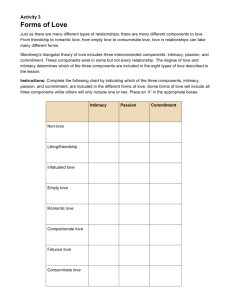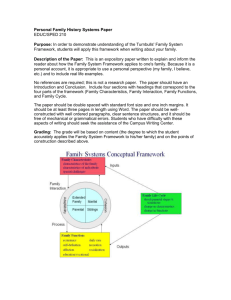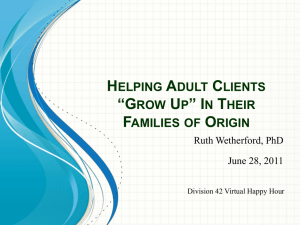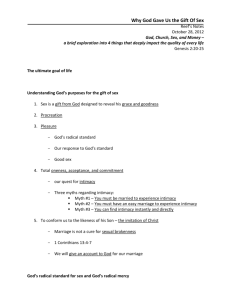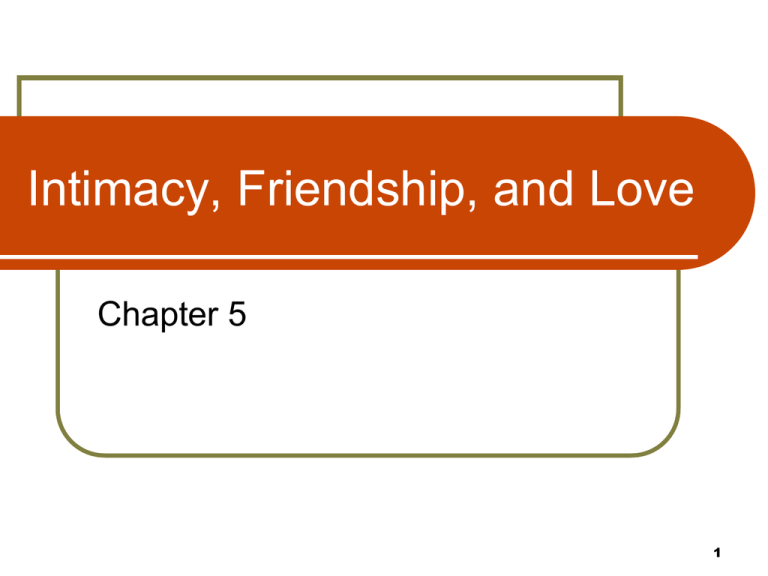
Intimacy, Friendship, and Love
Chapter 5
1
Chapter Outline
The Need for Intimacy
Gender and Intimacy: Men and Women as
Friends and Lovers
Showing Love: Affection and Sexuality
But What Is This “Crazy Little Thing Called
Love?”
Finding Love and Choosing Partners
How Love Develops and Ends: Spinning
Wheels and Winding Clocks
2
The Need for Intimacy
Humans require other humans with
whom we feel close and to whom we can
commit.
In psychologist Abraham Maslow’s
hierarchy of needs, after the meeting of
our physiological needs and needs for
safety, our social needs—for intimacy
and love—are the most fundamental of
human needs
3
The Need for Intimacy
Intimacy
Closeness between two people
Intimacy consists of four key features:
1.
2.
3.
4.
Love and/or affection
Personal validation
Trust
Self-disclosure
4
The Intimacy of Friendship and
Love
Friendship and love are the two most
important sources of intimacy people have
Friends may be deemed desirable on the
basis of their specific combination of unique
attributes.
Romantic partners are more carefully selected,
and their desirability is more carefully
evaluated
Commitment to the relationship
Reproductive success
Eventual attachment to offspring
5
Why It Matters: The Importance of
Love
Love is essential to
our lives.
Popular films, such
as Slumdog
Millionaire, reflect
how much American
popular culture
emphasizes
romantic love.
6
Love across Cultures
Neither “falling in love” nor the experience of
romantic love are unique to Americans.
Romantic love is functional in industrial
societies
Validates the importance of individual autonomy
and freedom from parental control
Establishes the relative independence of the
conjugal family from the extended family
fits with the wider social freedoms granted to
adolescents and young adults
7
Gender and Intimacy: Men and
Women as Friends and Lovers
There is a gender bias in our cultural
constructions of love that distorts our
understanding of how both men and
women love.
Much of what women do as expressions
of love consists of instrumental
displays, consisting of tasks associated
with nurturing and caregiving, more than
expressive displays
8
Gender and Friendship
There are gender differences in
disclosure in same-sex friendships.
This gender difference is accentuated in
adolescence and persists into and
through adulthood.
9
Gender and Love
With regard to love, the genders differ in
a number of ways.
For example, men see sex as a means of
expressing or showing love while for
women, to feel loved requires more than
sexual expression.
Gender differences may be more
exaggerated in what people say than in
what they do.
10
Exceptions: Love in
Nontraditional Relationships
Peer marriage
a relationship built on principles of equity,
equality, and deep friendship.
The emphases on equity and equality
resulted in shared chores, equal say in
decision making, and equal involvement in
child rearing.
Couples such as these are uncommon
11
Showing Love: Affection and
Sexuality
Although love and sex are separate
phenomena, recent research shows that
for both men and women, sex often
includes intimacy and caring, key
aspects of love, and love is most often
expected to include sexual desire.
Gender differences have been observed
in the relationship between love and sex.
12
Sexual Orientation and Love
Love is equally
important for
heterosexuals, gay men,
lesbians, and bisexuals.
For lesbians, gay men,
and bisexuals, love has
special significance in
the formation and
acceptance of their
identities.
13
But What Is This “Crazy Little Thing
Called Love”?
Despite centuries of discussion, debate,
and complaint by philosophers and
lovers, no one has succeeded in finding
a single definition of love on which all
can agree.
We may not so much have formal
definitions of love as we do prototypes
of love
14
But What Is This “Crazy Little Thing
Called Love”?
In order, the 12
central attributes of
love listed are as
follows:
Trust
Caring
Honesty
Friendship
Respect
Concern for the
other’s well-being
Loyalty
Commitment
Acceptance of the
other the way he or
she is
Supportiveness
Wanting to be with
the other
Interest in the other
15
Studying Love
Hatfield and Sprecher’s Passionate
and Companionate Love
Divides love into two types
Passionate - “an intense longing for union with
another”
Companionate - the warm and tender affection
we feel for close others
16
Studying Love
Sternberg’s Triangular Theory of Love
According to the theory, love is
composed of three elements that can be
visualized as the points of a triangle:
Intimacy
Passion
decision or commitment.
17
Love and Attachment
18
Love and Commitment
The following factors interact to increase
or decrease commitment:
The balance of costs and benefits
Normative inputs
Structural constraints
19
Finding Love and Choosing Partners
People select each other in a kind of
marketplace of relationships.
Halo effect
The assumption that good-looking people
possess more desirable social
characteristics than unattractive people.
20
Finding Love and Choosing Partners
In mixing with and
meeting people, one
doesn’t necessarily
gravitate to the most
attractive person in
the room but rather
to those about as
attractive as oneself.
21
Going Out, Hanging Out, and
Hooking Up
Research indicates that dating practices
have become more diverse, but “its
purposes and activities are similar to
when it first emerged”
The actual process of beginning a
relationship:
Seeing
Meeting Face to Face
Meeting in Cyberspace
22
Wheel Theory of Love
Love develops and is maintained
through four processes:
1.
2.
3.
4.
Rapport
Self-revelation
Mutual dependency
Fulfillment of intimacy needs
23
Reiss’s Wheel Theory of Love
24
The Clockspring Variation on
Reiss’s Wheel Theory
25
Jealousy
Occurs because of a partner’s real,
imagined, or likely involvement with a
third person.
Most likely in committed relationships
because of the presumed “specialness”
of the relationship.
Fear of loss, coupled with insecurity,
increases the likelihood of jealousy.
26
Styles of Unrequited Love
Cyrano style - Desire for a relationship
regardless of how hopeless.
Giselle style - Misperception that a
relationship is likely to develop.
Don Quixote style - Desire to be in
love.
27
Time and Romance
Time affects romantic relationships.
The rapid growth of intimacy tends to
level off, and we become habituated to
passion.
Commitment tends to increase, provided
that the relationship is judged to be
rewarding.
28

